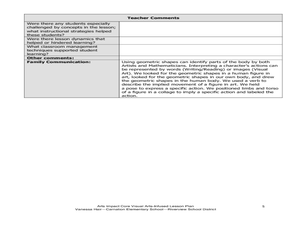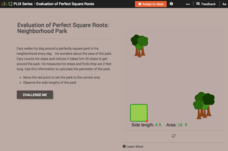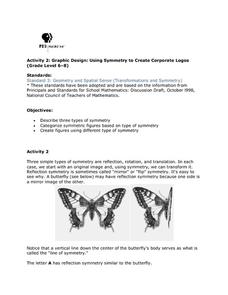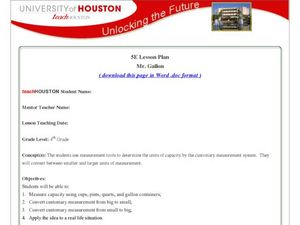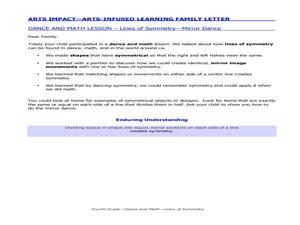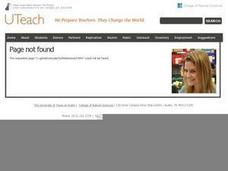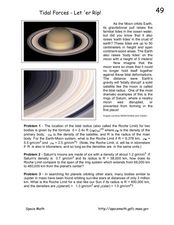Curated OER
Bodies In Motion: Shapes and Gestures
Students use geometric shapes to describe body parts. In this geometry lesson, students use geometry vocabulary as they discuss body parts. They practice drawing bodies using shapes based on a wooden model that is poised to show specific...
Curated OER
Weight Training
Students conduct a class-wide survey collecting, compiling, and analyzing data about fitness, weight loss, and body image issues. They analyze the relationship between exercise and diet in weight control.
Curated OER
Astronomy in the Round
In this round astronomical bodies worksheet, students use 6 photographs of various solar system bodies to answer 5 questions related to the roundness of these bodies. They create a number to represent the roundness of an object and they...
Curated OER
How Fast Does the Sun Spin?
In this rotation of celestial bodies worksheet, students determine the speed of the sun's rotation and they determine the number of days it takes the sun to rotate once at the equator. They identify the geometric factor that causes...
Curated OER
Cross Sections and Collision Times
High schoolers solve five problems including finding the cross sectional area of two bodies, determining the swept out volume of a moving body, finding the average particle volume of a body and determining the collision time for a body.
Curated OER
Lakes of Methane on Titan
In this methane lakes worksheet, learners read about the false-color synthetic radar map taken by the Cassini spacecraft indicating methane lakes on Titan. Students solve 4 problems about the surface area of the lakes from the image, and...
CK-12 Foundation
Evaluation of Perfect Square Roots: Neighborhood Park
Walking in the park can be good for the body and for mathematics skills. Young scholars use an interactive app to investigate the relationship between squares and square roots using a square with adjustable length. The program also...
CK-12 Foundation
Venn Diagrams: Planets and Dwarf Planets of the Solar System
Yes, Venn diagrams are helpful in science, too. Learners use an interactive to classify celestial bodies as having moons, as dwarf plants, as both, or as neither. They answer a set of challenge questions based on the Venn diagrams they...
Curated OER
Black Holes...V
In this black hole activity, high schoolers read about the black hole in the center of the Milky Way Galaxy called Sagittarius A and observe a Chandra image of the area where the black hole exists. Students solve two problems which...
Curated OER
Black Hole...Fade-out!
In this black hole worksheet, students read about how images fade to black when they reach an event horizon of a black hole. Students solve 3 problems about black holes using a given equation for luminosity. They find the time it takes...
PBS
Using Symmetry to Create Corporate Logos
Young mathematicians investigate the use of symmetry in graphic design. After first learning about reflection, translational, and rotational symmetry, children use this new knowledge to identify symmetry in letters of the...
Curated OER
Mr. Gallon
Students investigate measurement conversions using a visual demonstration. In this mathematics conversions lesson, students create an image of a plastic gallon jug using a paint software program. Students utilize the jug...
Curated OER
Is There A Formula for People?
Young scholars explore proportions which are typical of the human body. Given a list of classic proportions from earlier centuries, students work in pairs to test the validity of the proportions. Pupils share their personal...
Curated OER
FOOTSTEPS IN TIME
Students measure and correlate their foot lengths and body heights, then use this data to estimate height of Laetoli hominids. They use metric measurement and graphing to determine these heights.
Curated OER
Sizing Up the Supersize Croc
Students examine and compare traits of humans and crocodiles. In this crocodile lesson students use a ratio to estimate the height of a person and compare that to a crocodile.
Curated OER
Money and health
Students write a proposal with an appropriate budget to establish a health day at school. They design this day to educate and promote good health. They educate other students about health care, inform students of health concerns, and...
Curated OER
Lines of Symmetry - Mirror Dance
Fifth graders analyze how to divide space or shape into mirror sections to create lines of symmetry. In this lines of symmetry lesson, 5th graders discuss symmetry in dance, math, and living. Students participate in a dance warm-up and...
Curated OER
Building a Telescope
Pupils construct a simple refracting telescope. They calculate the magnification.
Curated OER
Tidal Forces-Let'er Rip!
In this tidal forces worksheet, high schoolers read about the gravitational pull from the moon that causes the ocean tides. Students solve 3 problems including finding the Roche or the tidal radius for the Earth and Moon, comparing the...
Curated OER
Applied Science - Science and Math Lab
Students explore the senses. In this Applied Science lesson, students investigate the items in "feely" boxes with their hands, both touching the items and shaking the boxes to hear the sound the items make. Students also smell and taste...
Curated OER
From Asteroids to Planets
In this asteroids and planets learning exercise, students read about the formation of planets from asteroids. Students solve 6 mathematical problems including finding the rate of growth of a planet, determining the mass of a planet at a...
Curated OER
Buzzing is BEE-lieving
Students investigate insects. In this insect lesson, students explore various insect models and identify the characteristics of each. Students observe insects outside and tally how many insects they observe.
Curated OER
Exploring the Ares 1-X Launch-Downrange Distance
In this Ares 1-X launch worksheet, students read about the path of this rocket's launch and solve 2 problems. Students find the number of seconds it took the rocket to fall from a given altitude and they determine how far from the launch...
Curated OER
Human Abstraction
Students explore and compare abstraction of human forms in various ancient cultures and by creating self-portraits using geometric shapes. They identify which geometric shapes form the following features: face, nose, arms, torso, legs,...
Other popular searches
- Media Literacy Body Image
- Children's Health Body Image
- Positive Body Image
- Body Image Media
- Female Body Image
- Body Image Concern
- Body Image History
- Body Image for Girls
- Body Image Kellogg's
- Better Body Image
- Body Images and Steroids
- Positive Body Image Girls
